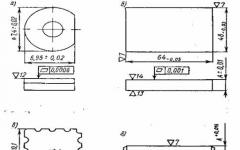Homemade moonshine stills based on a pressure cooker have recently gained immense popularity among consumers. The advantages of such a unit are undeniable. Firstly, a pressure cooker can be bought at any hardware store. Secondly, it is an absolutely sealed container equipped with two holes for the inlet and outlet valves. Thirdly, the built-in thermometer allows you to control the boiling temperature.
In order to make it out of a pressure cooker with your own hands, you only need to increase the holes on the lid, add a refrigerator, a steamer and the simplest communications in the form of silicone hoses. How to do it right - in our article. Here you will also find videos from experienced moonshiners and assembly recommendations.
A pressure cooker is a household appliance or pot with a hermetically sealed lid. Due to this sealing, an increased pressure is formed inside during operation, which allows you to cook food at a higher temperature. This is very suitable for the distillation of mash. The pressure inside the pressure cooker reaches 200 kPa, which, on the one hand, allows the mash to boil faster, on the other hand, to increase the rate of evaporation of alcohol-containing vapors.
What pressure cooker will make an excellent moonshine
When choosing a pressure cooker, you need to pay attention to the wall thickness and the material from which they are made. Optimal is a pressure cooker made of high-quality food grade stainless steel with a flat surface. This makes it possible to put the unit on any plane. Be sure to have 3-4 layers of the bottom, which will prevent burning and heat loss. Choose those devices that are used on a particular type of burner - gas, electric or induction.
In addition, if you are just starting to learn how to make moonshine, it is better to purchase an electric pressure cooker equipped with a heat sensor. This will allow you to set a certain temperature and maintain it throughout the entire time of distillation of the mash.
The disadvantage of such an apparatus is only one - a small volume. The largest household pressure cooker consists of a 6-liter bowl. From this amount of mash you get only 1-1.5 liters of "dirty" moonshine, and if you remove the tails and head and overtake again, you get 0.75 liters. A little, of course, but quite enough for home use. Moreover, the cooking process itself is so simplified by the presence of a pressure cooker that it can be repeated on the same day.
Braga is poured into the pressure cooker only 2/3 of the volume.
We collect moonshine from a pressure cooker
Saw holes in the lid of the pressure cooker, into one of which a fitting or a futor is inserted, and into the second - a bimetallic thermometer.
The sanitary futor provides the most tight connection, so it is better to stop at such threaded connections. You will need 2 feet of 1/2" thread for the lid.
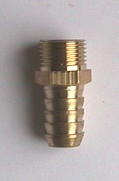
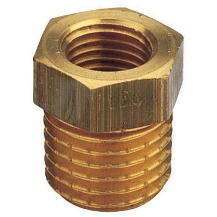
A silicone hose is put on the futor to connect to the coil, and insert a bimetallic thermometer into the second, if there is no built-in one on the pressure cooker.
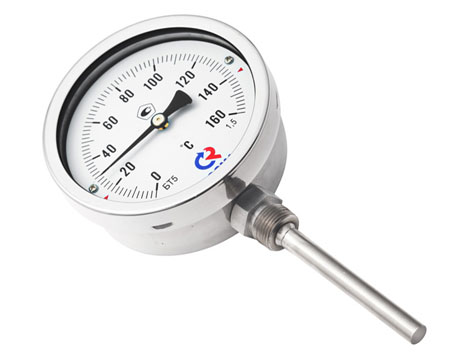
All connections must be absolutely tight so that alcohol-containing vapors do not pass. Some prefer to make silicone plugs, others use regular dough.
The connecting tubes that connect the distillation cube and the coil can be made of silicone - a relatively inert material that can withstand high temperatures, as well as glass - ideal. You can opt for a copper tube, it also does not react with alcohol. It is strictly forbidden to use plastic and rubber hoses - a pungent smell and bitterness will nullify all efforts to prepare a drink.
This is how the assembly diagram of a moonshine still from a pressure cooker looks like:
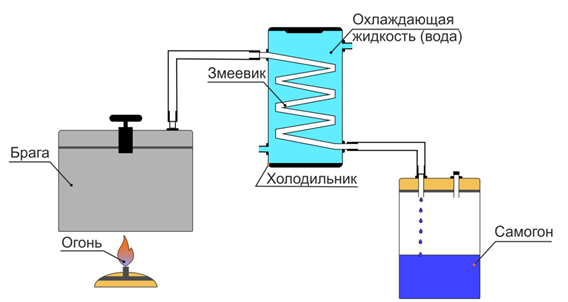
Condenser (Graham refrigerator)
In relation to moonshine stills, this part is often called a coil and it is intended for the movement of alcohol-containing vapors and the formation of condensate due to cooling with water. An ideal coil is considered to be a glass spiral tube, where the entire process of steam separation into fractions will be visible. In fact, a copper tube is in no way inferior to a glass one, with the only exception being that it is opaque.
For high-quality bending of the copper tube under the coil, sand is first poured into it, after which it is wound onto the base. If sand is not used, the thickness of the deflection will be uneven, and in some places the walls will touch, preventing the free passage of vapors.
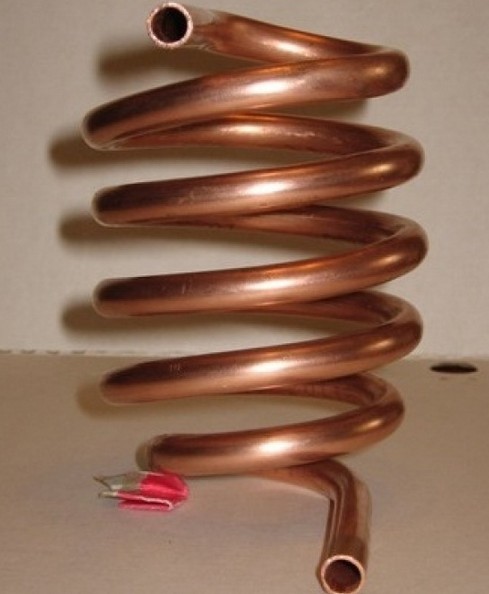
All refrigerators with a coil are divided into 2 types:
- flowing;
- jellied.
The flow-through refrigerator is connected to the plumbing system and constantly passes water through itself. A prerequisite for the quality operation of the refrigerator is cold water. If the moonshine is warm at the exit, then the distillation is going wrong, which will lead to a reduction in the finished product.
Cold water is always supplied from below, and always discharged from above, so that the counterflow contributes to the timely cooling of the coil.
The jellied refrigerator can be used only when it is not possible to supply cold water. Not because of laziness, no time and desire, but because it is impossible. The principle of the jellied refrigerator is that a large amount of ice water is immediately poured, some even add ice. But the water still heats up over time, and the condensation of steam is slower. On such a refrigerator, drain from above and forcibly pump out water, simultaneously supplying cold water from below.
Connection of elements
After all the elements are prepared, they are interconnected by means of silicone tubes. Often PVC pipes are sold under the guise of silicone. They are not suitable for joining, as they leave an unpleasant odor at the exit. How to test silicone or pvc? It's very simple - set it on fire. Silicone burns badly and does not smell.
All connections must be tight, for which they should be blown and checked in advance. Most often, holes and joints are closed with the usual dough of water and flour. If we are talking about a home-made moonshine based on a pressure cooker, this option is quite suitable. But if you plan to distill large volumes of moonshine, then there will be a lot of trouble with the dough - every time you clean it, you will have to scrape it off and do it again. And this time is garbage.
The question of the presence of this element of the system causes a huge amount of controversy. Some insist that a sukhoparnik is necessary, since it additionally cleans the finished product from fusel oils. Others, on the contrary, say that there is no point in the additional design of such a trap, a second distillation will still be required. We do not know which side of the barricades we will take, so we will tell you about the manufacture of a dry steamer.
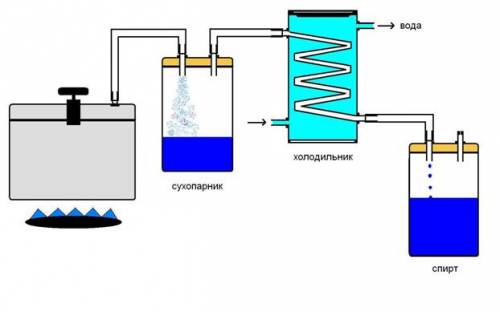
The main task of the steamer is to capture rapidly cooling fusel oils and prevent them from entering the final product. It can be made from an ordinary glass jar with a capacity of 1 or 2 liters with a hermetically screwed lid. In the cover, pre-make holes for the fittings. You screw them in and connect them with silicone hoses on one side with a distillation cube, on the other - with a refrigerator with a coil.
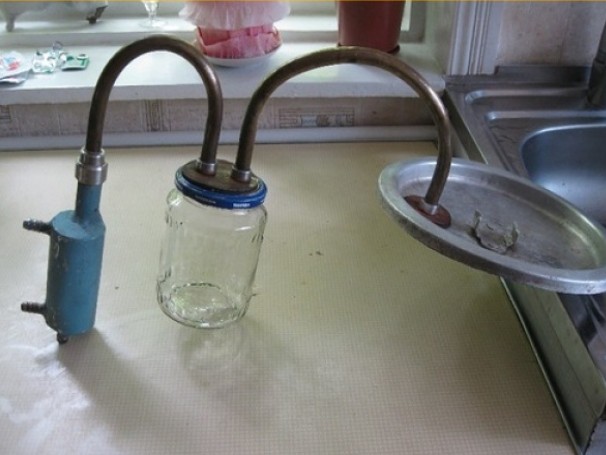
Some argue that if you put orange or lemon peels in a steamer, you get moonshine with a citrus flavor. We tried, we didn't succeed. It will be much more effective to insist moonshine on the same peels for 3-7 days, and then a citrus aroma will be clearly felt (this will not affect the taste in any way).







